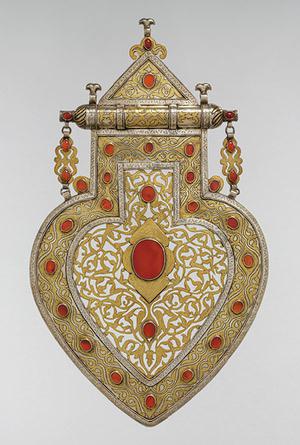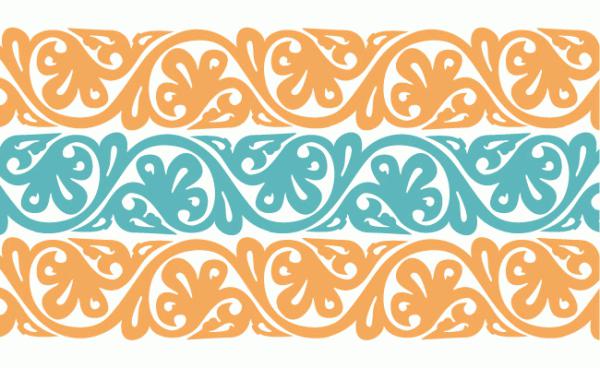To learn and understand the traditions of a people is possible only through its cultural and artistic heritage. The oldest human activity is the decoration with different images of oneself, one's clothing, home, various objects, tools, weapons. A widely used form of image art is an ancient ornament. It cannot be separated from the subject on which it exists. But more often it is by itself more valuable and is a work of art. In style, there are geometric, floral, in appearance - pictorial, sculptural, graphic ornaments. Any beautiful ornament carries a certain motive, consisting of one or more elements. This set of elements in the ornament is always framed as a single work. By the method of depicting elements, by how the master created a pattern of patterns, how he combines motifs from flora or fauna with material or geometric motifs with the shape of an object, you can determine the cultural and historical roots of an ornament, its belonging to a particular people.

And when an ornament is classified, they first talk about its origin, and then determine the purpose and content. The value of the ancient ornament, in all its national diversity, in the development of modern types of applied art is difficult to overestimate.
Classification of the variety of ornaments
Drawings decorating pottery and chasing on silver trays; scheme of patterns on ancient self-woven carpets, fabrics; A specially woven rope - ornaments of this type arose as a result of people's activities (as they later began to say - professional), and therefore are called technical. In the countries of the East, various symbols and signs were often woven into the ornament. This type is called symbolic. And the combination of symbols with complex technical elements without a specific plot has given widespread development to the geometric type. These are gothic and Arabic style ornaments.
The plant type is considered the most common and ancient. The motives are from replicas of flowers, fruits, plant leaves to their unrecognizable styling. And here, every nation has its favorite and revered plants. As well as on animal ornaments, ancient masters depicted wild animals that they hunt, or those that are sacred to them, as well as living next to them and therefore especially revered.

The fantastic type of ornament is based on non-existent plants or animals. Antique Rome, where subjects with theatrical and musical art, luxurious life or military weapons were especially fond of, is the birthplace of object ornament. The sky and stars, the sun and moon are elements of astral ornaments characteristic of China and Japan. Immediately a beautiful landscape-type ornament was born: on it mountains, rivers, waterfalls, forests and fields. In Arab countries, a special development, which arose with the advent of the first writing, consisting of letters and fragments of text, is a calligraphic type of ornament. All types of ornaments rarely exist in their pure form, more often they are intertwined, penetrate and complement each other.
Features of Arab Art
The works of art created by the peoples of the countries of the Arab world are distinguished by special spirituality, expressiveness, and a subtle sense of beauty and sublime. Arabic patterns and ornaments are unique and original with a striking variety. It is based on the Muslim religion, which prohibits the depiction of man, animals, living beings in general. Therefore, for example, the Arabic ornament extremely rarely includes elements of fauna, and then in a stylized form. Islamic culture is closer to geometric motifs, which are overwhelming with a sense of continuity of movement and immerse a person in the world of contemplation, dreams, the desire to learn the secrets of life.
The Arabic ornament is the basis of the plastic work of Muslims, which has become the art of artistic depiction of words, sayings, aphorisms from the Koran, sacred to them - calligraphy.
Ornament as an art form of Arabs
The study of patterns and relationships with the society of ornamental art makes it possible to apply everything progressive from the past in art today. Arabic ornament as the most important a component of the subtle and peculiar art of the East has a special aesthetic content and is a valuable part of world culture.
Forms they amaze with the most complicated simplicity and seething calm, they get used to reality and become a barrier between the world and man. Arabic ornament exposes the deep inner world of the masters who create it. It seems that they have learned to manage their own talent, enriched by experience, to reproduce so subtly all the shades of human experiences. In order to most fully reveal the planned motif of the Arabian ornament, the master uses different forms, giving them a new sound using the language of color and light.
The graphic element dominates, and the ornaments of the Arab masters seem voluminous, dynamic. Creatively transforming the whole space, the authors erase the boundaries, turning their work into a dream come true. This is a very important feature that distinguishes Arabian patterns and ornaments from any others.
The law of rhythm in the ornament
For a person, the phenomenon of rhythm is familiar. Day and night. Sleep and wakefulness. Therefore, we are waiting for him in works of art: in music and versification, in painting and architecture. Rhythm is order. Violation or lack of rhythm is alarming or even annoying. It is thanks to the presence of rhythm that we are happy and full of surprise, admiring the beauty of the works of art of Arabic ornament on gypsum, brick, wood, copper, silver. It seems that the master combined the material and the pattern of the ornament in rhythm , emphasizing the beauty and value of the material with the pattern. Different elements of the ornament are subject to a certain rhythm, and in relation to each other they are in rhythm. The master of Arabic ornament is akin to the conductor in the orchestra. Therefore, the real works of ornamental art are so harmonious.
Types of arabic ornaments
To understand where the Arab masters drew their inspiration from, one must imagine the endless deserts of North Africa and the Arabian Peninsula: an open, boundless space, rugged by winding paths, riverbeds, hills. Before my eyes, the gilding of sand merges with the bright blue sky and rivers, and closer to the water, curly fragrant greens and unusually bright flowers. The masters adapted and adapted in the ornament all that surrounded them for centuries. There are a lot of motives. There are recognizable elements, for example, from ancient culture, and there are so abstract that it is almost impossible to recognize the prototype. An important element in the Arabic ornament is the knot. The roots of this are in the Muslim religion. In the East, various images of a knot in an ornament have a blessed meaning for long life, happiness. It is often used not just for communication, but for converting one type of ornament into another and further into something completely abstract.
Girikhov knot
Girih is a geometric type of ornament. The main elements are figures: circle, oval, triangle, square, polygons. All of them are symbols on which the universe is built. For example, a circle represents center and movement, a square is associated with order and clarity. From these symbolic figures, Arabian masters, repeatedly interlacing and overlapping one another, create a complex, mathematically precisely verified ornament.
And if we consider the Arabian ornaments in general (in a mosque, for example), then the combination of geometric shapes in space delights. It captivates the accuracy of the selection of the ornamental pattern with the shape of the arches of galleries, the shape of windows. What an amazing color scheme of the ornament on the ceiling and walls, on the gables and on the floor! All this is separate and together voluminous due to the play of light and shadow.
Islimi - the path to the divine garden
At the heart of this Arabian ornament are images of an endless spiral with leaves and flowers. This is either a symbol of the continuous journey into the Garden of Eden or the idea of the ongoing development of a flowering green shoot. The islimi ornament has five forms: wicker, simple, forked, almond-shaped and winged. These forms do not exist separately, they complement and fill other motifs of the Arabic ornament, which does not tolerate voids.
Khatai is a simplified islimi. The same stems and branches, but abstract. In Arab countries, it is often used on the facades of houses, when painting jugs and in carpet ornaments.
Islamic arabesque
In the Islamic world, arabesque is a common type of ornament. He decorated household items, and secular buildings, and religious buildings. This type of ornament is based on repetition of fragments in a certain rhythm and does not carry any image. It virtually eliminates the background, because the elements fit one into the other.
In the continuous weaving of the pattern, the form disappears with an eternal Arabic hint of infinity. The main elements of the arabesque are the parts of plants and weaving, connected in a unique pattern, going to infinity.
Arabic calligraphy
A special decorative quality in Arabic calligraphy. The emergence of the alphabet and writing is generally considered the greatest invention of mankind. Ancient stone inscriptions from the village of Nabat, which have survived to this day and were made in pre-Islamic times in Arabic, confirm that the Arabs borrowed the alphabet from the neighbors of the Nabat people living in the north-eastern Arabian Peninsula. For Muslim Arabs, knowledge of the alphabet and reading was sanctified and encouraged by the Qur'an. The Arabic language is, in fact, the language of this sacred book for any Muslim. And like the Qur'an, it has become a unifying factor for the Arab people. It was used for communication and written by educated people from any class with different religious views. This is the true democratic meaning of the Arabic script. And naturally, he became an instrument of creativity. Masters of calligraphy, especially those who wrote by the Naskh method (he wrote the Quran), occupied a privileged position in society, close to power. Arabic calligraphy is a noble, sublime and unifying art. Thanks to her, the sacred in the Qur'an acquired a tangible form. Very often, masters of wall ornaments inscribed Arabic calligraphy in their works in the form of sayings from the Holy Scripture: “Praise be to one God”, “Power belongs to God”; or individual words: “Happiness”, “Life”, “Eternity”.